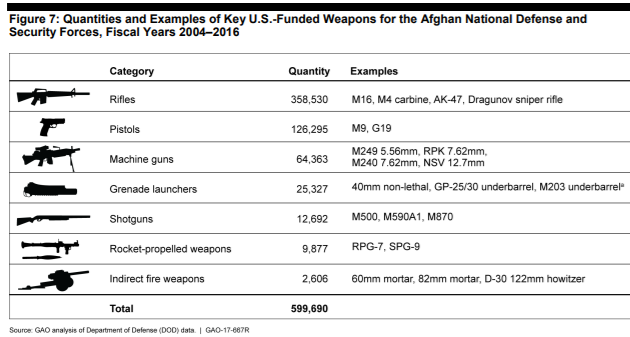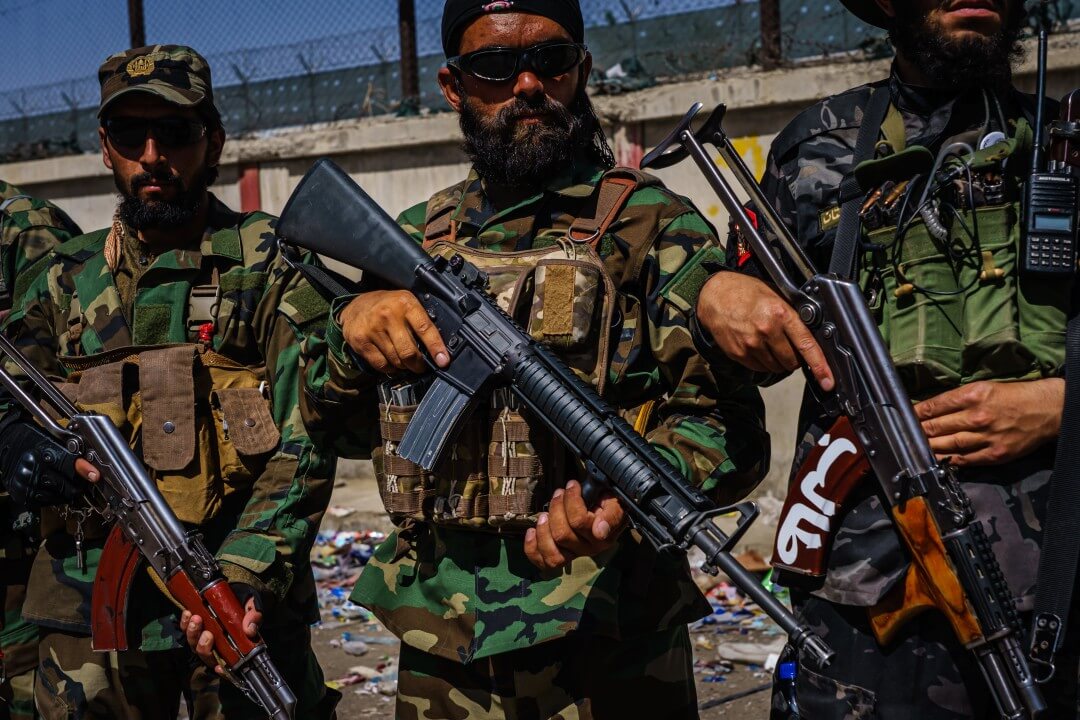Tanks, Humvees, armoured vehicles, assault rifles, and even a Black Hawk helicopter. These were some of the military equipment that the Taliban proudly displayed in a military parade in Kandahar earlier this month. Apart from effectively handing over Afghanistan to the Taliban, the United States (US) also unintentionally gifted the militants with billions of dollars worth of sophisticated military equipment.
Since seizing control of the country, soldiers of the Taliban have been frequently spotted roaming the streets of Kabul in standard US military camouflages, adorning bulletproof helmets fitted with night vision goggles, and wielding M-4 and M-16 rifles. According to a 2017 US Government Accountability Office report, the US funded almost 600,000 key weapons—including rifles, grenade launchers, and machine guns—to the Afghan National Defence and Security Forces (ANDSF) between 2004 and 2016. Furthermore, according to reports, the US left behind more than 200 different types of aircraft, including black hawk helicopters and C-130 Hercules transport aircraft. To add to this vast array of military equipment and weapons, the Taliban has also captured several military vehicles, drones, artillery pieces, tanks, and millions of bullets.

However, the Taliban cannot expect a smooth ride ahead. Many have argued that the group will face numerous challenges while trying to operate most of the equipment.
Firstly, US officials have highlighted that before leaving Afghanistan, American forces “demilitarised” most of the sophisticated equipment that was left behind, rendering it of no significant use for the Taliban. Last month, Gen. Kenneth McKenzie, commander of the US Central Command, said that several military assets, including cars and aircraft, were stripped of their bare essentials and would not serve the Taliban in any way. “Those aircraft will never fly again when we left. They’ll never be able to be operated by anyone. Most of them were non-mission capable, to begin with, but certainly, they’ll never be able to be flown again,” he noted.
Another challenge facing the Taliban is its lack of technical expertise, particularly with regard to operating any aircraft that could be used. For instance, a former Black Hawk pilot for the US army told NPR that flying the helicopter is “not something that you can do in a week or a month” and requires years of training. “Someone could get in there, maybe find some operating manuals and figure out how to get the engine started, the rotors turning and get it up in the air. But they’d probably be more of a danger to themselves than to anyone else at that point,” he said.
Even if the Taliban is able to figure a way out to operate all the sophisticated weaponry in its possession, the equipment would still need to be serviced regularly. Since the US has no plan to recognise the Taliban any time soon, repairing and maintaining its newfound arsenal would prove to be a tedious task. After all, even the Afghan army, when it existed, was dependent on spare parts, contractors, and regular servicing to keep its equipment in top shape.
Finally, claims by former US President Donald Trump that the Taliban had acquired $85 billion in US weaponry were put to rest by The Washington Post. The Post debunked the claim by stating that $85 million was the figure for all US spending on Afghanistan since 2001, not just on military equipment. It further stated that only about 29% of the funds spent on the Afghan military went to equipment and transportation—roughly $24 billion—suggesting that US weapons captured by the Taliban are not as vast as it is expected to be.
That being said, $24 billion is still a huge number and a lot of the weapons in the Taliban’s new arsenal could easily be put to use. Jonathan Schroder, a military expert, notes that they “don’t need a lot of skill or training to use” small arms and night vision goggles, which could significantly bolster the Taliban’s military capabilities by adding to their weapons and enabling them to work in difficult terrain and during the night.
#Taliban fighters enter a hangar in #Kabul Airport and examine #chinook helicopters after #US leaves #Afghanistan. pic.twitter.com/flJx0cLf0p
— Nabih (@nabihbulos) August 30, 2021
Schroder also adds that the artillery pieces in the group’s possession could be a game-changer for them, as they can target adversary positions from long distances and be moved easily. Additionally, artillery is also a lethal piece of equipment and could prove to be a strategic advantage for the Taliban in any military confrontation. For instance, it was reported that the militants used towed artillery as well as armoured vehicles and mortar shells to defeat the Afghan resistance in Panjshir.
The possession of US military equipment could also prove to be a diplomatic boon for the militants. Schroder mentions that China, Iran, and Russia could potentially be interested in examining and using US equipment. By allowing these countries access to their war booty, the Taliban stands to gain much-needed support in the international arena.
The Taliban could also find a potential source of revenue by selling some of the weapons and equipment in its possession. In this regard, it could sell some of the avionics and communications equipment on aircraft to interested parties. According to reports, the Afghan arms trade has already begun to flourish since the Taliban captured US weapons, indicating that the group has wasted no time in selling its loot to replenish its coffers.
Furthermore, new weapons could embolden the Taliban to exert tighter control over Afghan society and prevent the outbreak of any major protests against its rule. In fact, Taliban special forces in US uniforms used gunfire to frighteningly disperse a protest march by women demanding equal rights from their new rulers.
Lastly, the Taliban seems to take a lot of pride in displaying and flaunting US weapons that were meant to be used against it. It offers the group a sort of symbolic victory against the US, who could be embarrassed by the weapons falling into the hands of the Taliban.
All things considered, the equipment left behind by the US are a boon to the Taliban, given all the ways the militants can use it to their advantage. Therefore, despite all the challenges the Taliban might face in handling the wealth of weapons in its possession, it can still wield them in its favour.

